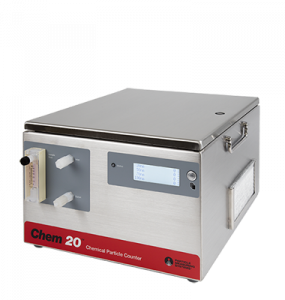A case study in how a 20 nm chemical particle counter provided critical photomask filter information.
Photomasks are used to transfer the minute, highly complex circuit patterns for semiconductors onto the wafers. After manufacture, mask blanks must be cleaned to remove residual particle contamination that will impact the integrity of the transferred circuit patterns, so fluid used for the cleaning process should also be free from particle contamination.
Contamination Cleaning at < 100 nm
Particle measurements were taken using a Chem 20™ chemical particle counter from Particle Measuring Systems (PMS) installed into a mask blank cleaning tool and connected at the point where fresh cleaning fluid was supplied to the cleaning bath. The first particle count was taken during the standard cleaning process, and the second count was taken after the installation of an additional filter immediately before the sample point. Ultrapure water (UPW) was the first cleaning fluid, the second a solution of potassium hydroxide (KOH).
The results with UPW were not as expected, with the particle counts found to be higher after installing the filter. The reason for this was not certain.  However, the UPW was already extremely clean to begin with, and it is possible that particles were introduced into the system when the filter was installed. When the test was repeated with the less clean KOH solution, the particle concentration decreased by over one order of magnitude.
However, the UPW was already extremely clean to begin with, and it is possible that particles were introduced into the system when the filter was installed. When the test was repeated with the less clean KOH solution, the particle concentration decreased by over one order of magnitude.
In this case, the Chem 20 particle counter data informed the manufacturer there was no benefit gained from using the additional filter with UPW as the cleaning liquid. The additional filter offered a significant benefit when using KOH as the cleaning liquid.
What’s Next?
Learn more about the Chem-20 Chemical Particle Counter, and look forward to our next blog on Process Tool Manufacturing. Until next time, check out the full analysis of all semiconductor applications discussed in this blog series!
Ready to get started?
